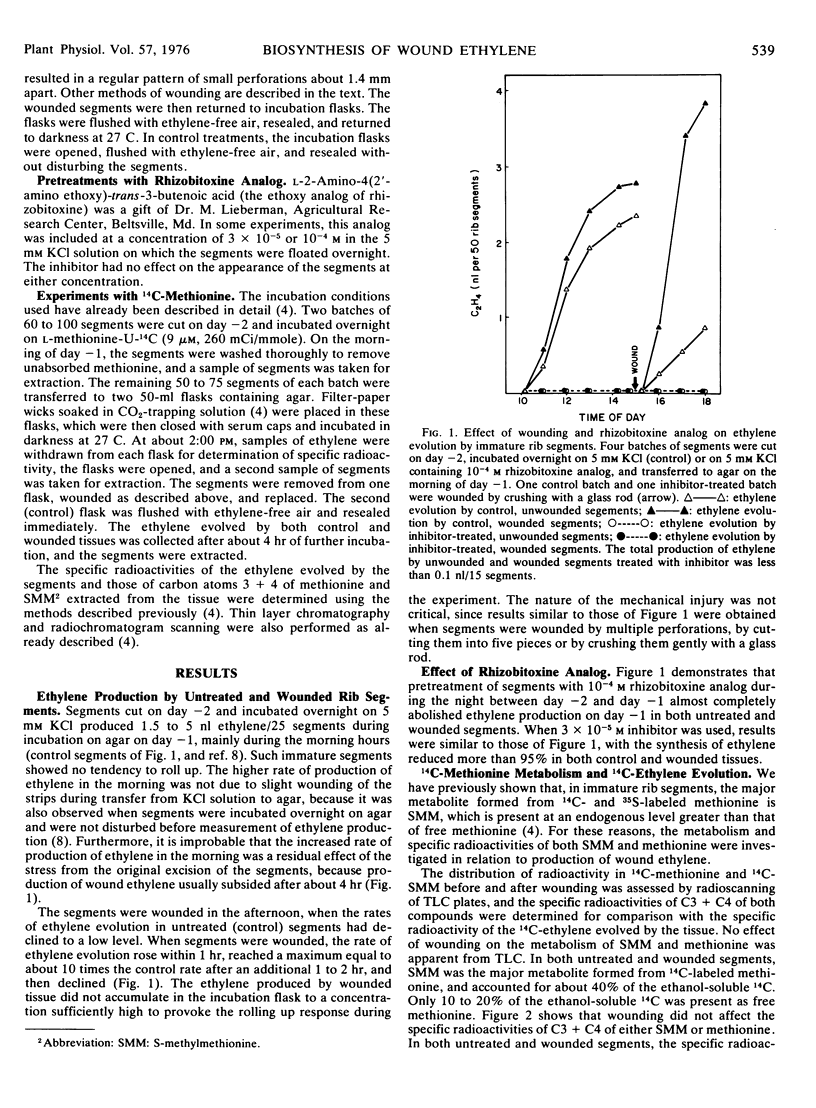Abstract
Production of wound ethylene was investigated in rib segments excised from flower buds of morning-glory (Ipomoea tricolor). Segments of the ribs were cut from buds 2 days before flower opening, floated overnight on 5 mm KCl solution, and transferred to agar the following morning. These immature segments evolved only a small quantity of ethylene during incubation on agar, with most of the production occurring in the morning. When such segments were wounded mechanically early in the afternoon, the rate of ethylene production rose more than 10-fold within 1 hour and returned to a low rate after about 3 hours.
Production of ethylene by both untreated and wounded rib segments was inhibited more than 95% by overnight pretreatment with the ethoxy analog of rhizobitoxine (3 × 10−5 and 10−4m). After overnight exposure of segments to 9 μml-methionine-U-14C, the specific radioactivity of the ethylene evolved by untreated and wounded tissue was determined and compared to the specific radioactivities of carbon atoms 3 plus 4 of methionine and S-methylmethionine (SMM) extracted from the segments. The specific radioactivity of methionine was about one-half that of SMM; neither value was significantly affected by wounding. The specific radioactivity of ethylene evolved by untreated tissue was close to that of SMM. In wounded tissue the specific radioactivity of the ethylene evolved was lower, but still above that of methionine. These results are consistent with the interpretations that wound ethylene is synthesized from carbon atoms 3 plus 4 of either SMM or methionine. On the basis of earlier experiments with senescing rib segments, it is suggested that methionine serves as the precursor of the wound ethylene.
Full text
PDF



Selected References
These references are in PubMed. This may not be the complete list of references from this article.
- Abeles A. L. Biochemical Pathway of Stress-induced Ethylene. Plant Physiol. 1972 Oct;50(4):496–498. doi: 10.1104/pp.50.4.496. [DOI] [PMC free article] [PubMed] [Google Scholar]
- Hanson A. D., Kende H. Ethylene-enhanced Ion and Sucrose Efflux in Morning Glory Flower Tissue. Plant Physiol. 1975 Apr;55(4):663–669. doi: 10.1104/pp.55.4.663. [DOI] [PMC free article] [PubMed] [Google Scholar]
- Hanson A. D., Kende H. Methionine metabolism and ethylene biosynthesis in senescent flower tissue of morning-glory. Plant Physiol. 1976 Apr;57(4):528–537. doi: 10.1104/pp.57.4.528. [DOI] [PMC free article] [PubMed] [Google Scholar]
- Herner R. C., Sink K. C. Ethylene Production and Respiratory Behavior of the rin Tomato Mutant. Plant Physiol. 1973 Jul;52(1):38–42. doi: 10.1104/pp.52.1.38. [DOI] [PMC free article] [PubMed] [Google Scholar]
- Kende H., Hanson A. D. Relationship between Ethylene Evolution and Senescence in Morning-Glory Flower Tissue. Plant Physiol. 1976 Apr;57(4):523–527. doi: 10.1104/pp.57.4.523. [DOI] [PMC free article] [PubMed] [Google Scholar]
- McGlasson W. B., Pratt H. K. Effects of Wounding on Respiration and Ethylene Production by Cantaloupe Fruit Tissue. Plant Physiol. 1964 Jan;39(1):128–132. doi: 10.1104/pp.39.1.128. [DOI] [PMC free article] [PubMed] [Google Scholar]
- Zeroni M., Ben-Yehoshua S., Galil J. Relationship between Ethylene and the Growth of Ficus sycomorus. Plant Physiol. 1972 Sep;50(3):378–381. doi: 10.1104/pp.50.3.378. [DOI] [PMC free article] [PubMed] [Google Scholar]


